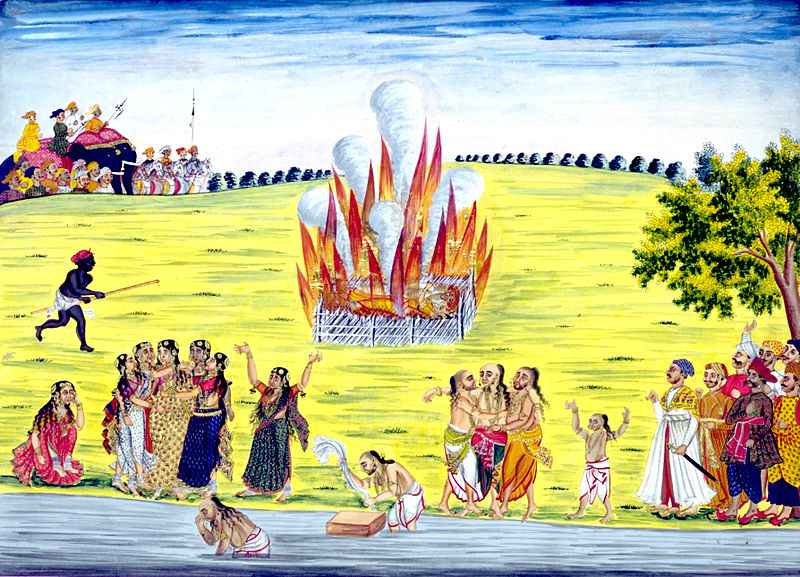Sati, also known as “Suttee,” was a tradition that was practiced in ancient India from the early centuries BCE to the mid-1990’s. In this tradition, widows were burned at the side of their deceased husbands. There were many reasons behind this tragic form of suicide, but the act was seen as heroic and courageous. The tradition originates with the goddess Sati, who burned herself to death in a fire that she created through her yogic powers, which she obtained after her father had insulted her husband. Sati became an option for women in India who were not “marriageable,” according to social norms. Sati was first recognized in the Mahabharata, one of the two most well-known and important poems of India.1
“LAMP of my life, the lips of Death
Hath blown thee out with their sudden breath;
Naught shall revive thy vanished spark . . .
Love, must I dwell in the living dark?” -Suttee by Sarojini Naidu2
The practice of Sati is recounted by a first century BCE Greek author named Diodorus Siculus. Diodorus mentioned sati stones, which were memorials of all of the wives that have passed along with their husbands. A stone was created for each wife after she gave up her life, and these stones were all collected into a shrine. The earliest memorial that has been discovered dates from 510 BCE.3

Another practice that branched out from sati was the Jahuar, which was a sacrifice of any Muslim woman from the twelfth through the sixteenth century. It was believed that if a woman was burned, she would be safe from rape, which was worse than dying at the hands of a conquering enemy.4
Sati was also practiced by the Brahmans of Bengal, by the system of law from 1100 CE, which was called Dayabhaga. If a woman was widowed, her inheritance would be given to the children of her passed husband. If she were to remarry, her inheritance from her deceased husband would be given to the children and her new husband and her other children would not receive anything. If she passed along with her husband, the inheritance would be given to the children of her dead husband. This law was ended by the Mughal rulers Akbar and his father Humayun in the sixteenth century.5
In 1829, when India was informally ruled by Great Britain, the law to make sati illegal was passed because the act was seen by the British as harsh and cruel to women. Although it was made illegal, there were controversies over whether the sati practice was a religious act, and if so, should that be taken into consideration before prohibiting it.2
In 1987, Roop Kanwar, a woman from the village of Deorala in Rajasthan India, was married to her husband for only eight months before he died. She decided against taking her life in front of thousands of people. Politicians and activists believed that Roop Kanwar was then subsequently drugged by the liquid inside the seeds of an opium poppy flower, and pressured to take her life by those around her. Some people even say that she had super natural powers because her eyes were glowing bright red as she burst into flames. Police concluded that a group of men had been guilty of having drugged her, and they were placed under arrest.7
Sati was a rather harsh tradition, but the significance of these rituals was important to many Indian traditions. The thought of self sacrifice in this way is foreign to Western traditions, and the thought of being burned alive is worse. Sati is now illegal and no longer practiced, but the memories of the dead women from this tradition remain and they will always remind us of this social practice.8
- Kashgar, 2009, s.v. “Life in India: the practice of sati or widow burning,” by Linda Heaphy. ↵
- The Denson Journal of Religion, April 2015, s.v. “Interpreting Sati: the Complex Relationship Between Gender and Power in India,” by Cheyenne Cierpial. ↵
- Dorothy Stein, Burning Widows (University of British Columbia: Pacific Affairs, 1988), 466. ↵
- The Denson Journal of Religion, April 2015, s.v. “Interpreting Sati: the complex Relationship Between gender and Power in India,” by Cheyenne Cierpial. ↵
- Encyclopedia Britannica, March 2015, s.v. “Suttee,” by Wendy Dongiger. ↵
- The Denson Journal of Religion, April 2015, s.v. “Interpreting Sati: the Complex Relationship Between Gender and Power in India,” by Cheyenne Cierpial. ↵
- Encyclopedia Britannica March 2015, s.v. “Suttee,” by Wendy Dongiger. ↵
- Sophia Gilmartin, “The Sati, the Bride and the Widow: Sacrificial Woman in the nineteenth century,” Victorian Literature Vol. 25, No.1 (1997): 142. ↵



99 comments
Sergio Cervantes
I cannot believe that citizens practiced this in India. How horrible it must have been for these women to burn themselves alive next to their deceased husbands! It is interesting to see how every culture views death differently, especially since some welcomed it as a way of “saving” themselves. I am surprised that this custom was not outlawed earlier. It is also intriguing to read about the stones that were dedicated to those women who decided on taking their lives.
Cameron Mays
I felt the urge to read your article by simply reading the title! This was a very interesting topic and really allowed me to see how something so bizarre can be seen as heroic and courageous. It is form of culture that is perceived to be normal in one’s life in ancient India. Although this seems completely out of the norm even in other countries today, it was simply a way of life. I see that you definitely did your research and went into great detail over the story behind why these women burned themselves. It was definitely an enjoyable read and I’d recommend it any day!
Teresa Valdez
The practice of Sati at first appeared tragically romantic, centering around woman who would rather be burned alive than live without their husband. As the examination of the practice continued, it became horrifyingly clear that the practice was continued out of tradition than grief. This is clear by the example of Roop Kanwar. Excellent article!
Hayden Hollinger
This was a very interesting article and it was incredible to think that this was actually carried out. I thought that you described this idea very well, and you did a great job of painting a clear picture of went on. It seemed like a blessing that the British intervened and made sure that sati was illegal. I found it so surprising that there was a case of this as recent as 1987.
Jennifer Pogue
Very interesting article! You did a great job of explaining how Sati practices changed over time. A woman must be truly dedicated to die because of her husbands death. Thankfully the British made all forms of Sati illegal and it is no longer practiced. I wonder if the Indian women at that time were terrified their husbands would die before them, or if each woman saw it as an honor. If the family had a young child, it must have been hard for them to have their father die and then their mother commit suicide. Overall great article.
Faisal Alqarni
Hi Anayeli, I cannot begin to think of the level of dedication to another person one needs to be able to carry out such an act of self-emulation. This kind of practice really just shows how seven though some traditions are there to uplift society some exist as a way of keeping the weak in society subjugated. I am glad this practice died out and nobody practices it anymore.
Aimee Trevino
Really interesting article! You did a really good job of explaining how Sati, the widow burning was practiced, and how it originated. It is insane that this was actually a big tradition that was carried out and practiced. I feel like it also goes to show how during these times women practically meant nothing, and especially without a male figure in their lives, which is really unfortunate. Overall, really well explained!
Gabriela Medrano
This was legit a really interesting article. What an incredible practice, cruel, but al the same was interesting. I cannot believe how woman had the gut to do such atrocities. I am glad the British intervened and the practice became illegal because I agree this was a harsh act on women. However, respect paid to those who suffered this death. I am now interested in asking present Indian woman what they think of the practice. Great article and awesome read!
Ana Gonzalez
Interesting topic! You did a good job explaining the way Sati was practiced and why women decided to sacrifice themselves if their husbands died. I’m glad Sati is no longer practiced because it is an unnecessary and cruel tradition that, in my opinion, punishes a women for not having a husband or a male figure in their life. I really like the excerpt of a poem that you included in your article. Well done!